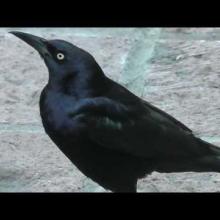

Join BirdNote tomorrow, November 30th!
Illustrator David Sibley and actor H. Jon Benjamin will face off in the bird illustration battle of the century during BirdNote's Year-end Celebration and Auction!
The range and abundance of the Great-tailed Grackle have expanded significantly since 1900, when the species barely reached Texas from Mexico. One winter roost of grackles in South Texas was pegged at 500,000 birds! Great-tailed Grackles can present pest management problems for agriculture and sanitation issues in urban areas. It’s worth noting that human alterations of the natural landscape invited the grackles in.
BirdNote®
Great-tailed Grackles On the Move
Written by Bob Sundstrom
This is BirdNote.
[Great-tailed Grackle song sequence of crackles, squeals, etc.]
This startling voice — one of cracks, clatters, wheezes, squeals, and trills — belongs to a male Great-tailed Grackle. Picture a very large blackbird, glistening with blue iridescence. Male Great-tailed Grackles are all of a foot and half long, and slender, with a long, spike-like beak and a very long tail, folded narrowly in the shape of a boat’s keel. Females are brown, and 25% smaller.
[Continue Great-tailed vocalizations]
The Great-tailed Grackle’s big story is one of expansion. In 1900, the species barely reached into Texas from Mexico. By 2000, it was found through much of the American Southwest. One winter roost of grackles in South Texas was pegged at 500,000 birds. [Huge flock of Great-tailed Grackles] Its leap in population has coincided with the advent of large-scale irrigation, industrial agriculture, and rampant urbanization.
[Continue Great-tailed Grackle flock sounds]
In their vast abundance, they present pest management problems for agriculture and sanitation issues around cities and towns. But it was, of course, these very human alterations of the natural landscape that invited the grackles in. We may as well enjoy them, because they’re here to stay.
[Repeat some of introductory song]
For BirdNote, I’m Mary McCann.
###
Bird sounds provided by The Macaulay Library of Natural Sounds at the Cornell Lab of Ornithology, Ithaca, New York. Great-tailed Grackle songs of individual birds and vocalizations of large flock [12634] recorded by L. Irby Davis. Huge flock of Great-tailed Grackles [12632] recorded by A.A. Allen. Ambient drawn from [105549] Green Jay track by G.A. Keller.
BirdNote’s theme music was composed and played by Nancy Rumbel and John Kessler.
Producer: John Kessler
Executive Producer: Chris Peterson
© 2014 Tune In to Nature.org June 2014/2021 Narrator: Mary McCann
ID# GTGR-01-2014-06-04GTGR-01




